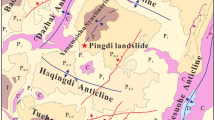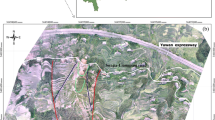Abstract
Extreme rainfall events have become an increasing component of the annual precipitation in China, which caused amounts of geological disasters, especially in Southwest China. At approximately 7 a.m. (Beijing time) on July 13, 2020, a catastrophic soil and rock landslide occurred in Baima Town, Wulong District, Chongqing, China. With a length of 750 m and a width of 125 m to 260 m, the landslide carried approximately 1.4 × 106 m3 of rock and soil debris and destroyed eight houses, two main roads, a shale gas pipeline, and a large amount of farmland. After the landslide failure, the accumulation zone still deformed responding to continuous rainfall. The failure mechanism of the landslide was analyzed based on the geological conditions, deformation process, and triggering factors. The research shows that the Niuerwan landslide had a complex deformation process. According to the deformation characteristics, the landslide is divided into five parts: the source area, the compression area, the rapid-sliding area, the landslide-affected zone, and the accumulation area. The source area was triggered by continuous torrential rainfall and controlled by mudstone and bedding plane. The variation of the microrelief in the study area has a significant effect on the failure model of the landslide. Precipitation triggered the failure of the steep source area which impacted the middle part. Eventually, a continuous sliding surface developed along with the weak layer, giving rise to catastrophic failure. Moreover, the accumulation area at the steep slope toe rapidly moved downward to form a debris flow under the combined action of the geological conditions and rainfall. The Niuerwan landslide is a complex rainfall-induced landslide with a unique evolution process, which can provide some useful information for the early warning and deformation mechanism of landslides in similar geological settings.








source area (zone A); a, b, e the boundary of the landslide; c the main scarp of the landslide; d the slip scratches on the sliding zone; f the slip scratches in the trailing edge of the landslide





Similar content being viewed by others
References
Bhandari BP, Dhakal S (2020a) Compositional analysis and phase relationship of soil mass from the active landslides of Babai River watershed. Siwalik Zone of Nepal Engineering Geology 278(5):1–15. https://doi.org/10.1016/j.enggeo.2020.105851
Bhandari BP, Dhakal S (2020b) Spatio temporal dynamics of landslide in the sedimentary terrain: A case of Siwalik zone of Babai watershed. Nepal SN Applied Sciences 2:854. https://doi.org/10.1007/s42452-020-2628-0
Chen L, Yang H, Song K et al (2021) Failure mechanisms and characteristics of the Zhongbao landslide at Liujing Village, Wulong, China. Landslides 18:1445–1457
Duan Z, Dong C, Zheng W, Tang H, Ma J (2020) liquefaction mechanism of terrace sandy silt under landslide impact. J Eng Geol 28(6):1362–1371
Eshraghian A, Martin CD, Morgenstern NR (2008) Movement triggers and mechanisms of two earth slides in the Thompson River Valley, British Columbia. Canada Can Geotech J 45(9):1189–1209. https://doi.org/10.1139/t08-047
Froude MJ, Petley D (2018) Global fatal landslide occurrence from 2004 to 2016. Nat Hazard 18:2161–2181
Huang RQ, Zhao SJ (2008) Formation and mechanism analysis of Tiantai landslide, Xuanhan County, Sichuan Province. Proceedings of the 10th International Symposium on Landslides and Engineered Slopes, 30 June 4, July 2008, Xi'an, China. Landslides and Engineered Slopes: From the Past to the Future 32(1):1171–1181
Huang Y, Xu X, Liu JJ et al (2020) Centrifuge modeling of seismic response and failure mode of a slope reinforced by a pile-anchor structure. Soil Dyn Earthq Eng 131:1–11
Hu X, Zhang M, Sun M et al (2015) Deformation characteristics and failure mode of the Zhujiadian landslide in the Three Gorges Reservoir, China. Bull Eng Geol Env 74:1–12
Hu X, Zhou C, Xu C et al (2019) Model tests of the response of landslide stabilizing piles to piles with different stiffness. Landslides 16(11):2187–2200
Li CR, Wang M, Liu K (2018) A decadal evolution of landslides and debris flows after the Wenchuan earthquake. Geomorphology 323:1–12
Rahmani H, Naeini S (2020) Influence of non-plastic fine on static iquefaction and undrained monotonic behavior of sandy gravel. Eng Geol 275:105729
Salvati L, Carlucci M (2015) Towards sustainability in agro-forest systems?. Grazing intensity, soil degradation and the socioeconomic profile of rural communities in Italy. Ecol Econ 112:1–13
Tsai TL (2008) The influence of rainstorm pattern on shallow landslide. Environ Geol 53(7):1563–1569
Yang HJ, Wei FQ, Ma ZF et al (2020) Rainfall threshold for landslide activity in Dazhou, southwest China. Landslides 17(1):61–77
Vita PD, Reichenbach P, Bathurst JC et al (1998) Rainfall-triggered landslides: a reference list[J]. Environ Geol 35(2):219–233
Wang LL, Bornert M, Héripré E, Chanchole S et al (2015) The mechanisms of deformation and damage of mudstones: a micro-scale study combining ESEM and DIC. Rock Mech Rock Eng 48:1913–1026
Wang LQ, Yin YP, Huang BL, Dai ZW (2019) Damage evolution and stability analysis of the Jianchuandong dangerous rock mass in the Three Gorges Reservoir area. Eng Geol 265:105439
Wen BP, He L (2012) Influence of lixiviation by irrigation water on residual shear strength of weathered red mudstone in Northwest China: implication for its role in landslides’ reactivation. Eng Geol 151:56–63
Wu XL, Chen XY, Zhang FB (2015) Global research trends in landslides during 1991–2014: a bibliometric analysis 12:1215–1226
Yang T, Rao Y, Wu Y et al (2021) Water softening-induced retrogressive landslides: experiments and theoretical calculations of back scarp inclination. Geomorphology 389:1–16
Yi X, Feng W et al (2021) Catastrophic landslide triggered by persistent rainfall in Sichuan, China: August 21, 2020. Zhonghaicun Landslide Landslides 18(8):2907–2921
Zhang S, Xu Q, Hu ZM (2016) Effects of rainwater softening on red mudstone of deep-seated landslide, Southwest China. Eng Geol 204:1–13
Zhang YM, Hu XL, Dwayne DT et al (2018) Field monitoring and deformation characteristics of a landslide with piles in the Three Gorges Reservoir area[J]. Landslides 15:581–592
Zhou C, Ai D, Huang W et al (2021) Emergency survey and stability analysis of a rainfall-induced soil-rock mixture landslide at Chongqing City, China. Front Earth Sci 9:1–15
Zhou C, Hu XL, Xu C et al (2018) Model test on deformation and failure of landslide in water-level-fluctuating zone of Three Gorges Reservoir region. China J Highw Trans 31(2):252–260
Zhou JW, Jiao MY, Xing HG et al (2017) A reliability analysis method for rock slope controlled by weak structural surface[J]. Geosci J 21(3):453–467
Funding
This work was financially supported by the Fundamental Research Funds for the Central Universities (2021QN1082); the Natural Science Foundation of Jiangsu Province (BK20221126)”, “China Postdoctoral Science Foundation (2022M710177).
Author information
Authors and Affiliations
Corresponding author
Ethics declarations
Conflict of interest
The authors declare no known competing interests.
Rights and permissions
About this article
Cite this article
Zhou, C., Huang, W., Ai, D. et al. Catastrophic landslide triggered by extreme rainfall in Chongqing, China: July 13, 2020, Niuerwan landslide. Landslides 19, 2397–2407 (2022). https://doi.org/10.1007/s10346-022-01911-w
Received:
Accepted:
Published:
Issue Date:
DOI: https://doi.org/10.1007/s10346-022-01911-w




